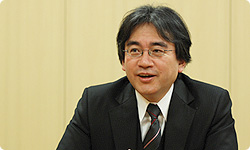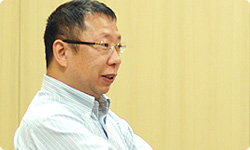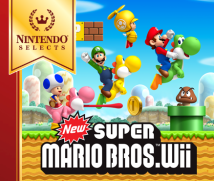5. Applying A Single Idea To Both Land And Sky
Tezuka-san mentioned a little earlier that, at the start, the idea was to have land, sea and sky making up the stages of the game. But there was actually a moment when we almost scrapped the sky element.
So you nearly got rid of the levels set in the sky?
That’s right. We got part-way through making these levels, where Mario would climb on clouds. Then partly due to memory constraints, we gave up. But because Tezuka-san felt really strongly about the sky levels, we managed to breathe life back into them by adding vines.
So the vines were your idea, Tezuka-san?
Yes they were. I thought that we could do something along the lines of Jack and the Beanstalk in Super Mario. All I really did was suggest that it would be good if Mario could climb up a beanstalk in order to get to the world in the sky. Miyamoto-san then ran with this idea and came up with the feature where you hit a block to make the vine grow .
So it really was a collaborative effort.
But while we may have got Mario up to the sky, we had a new problem - how to bring him back down.
We had no means of getting Mario to descend from the sky level so initially we thought that we could have him jump down. But it wouldn't normally cross your mind to jump down.
You’d be worried about losing the turn, wouldn’t you? (laughs)
That's right. We were all very concerned about this until one of the younger members of the team hit upon the idea of positioning coins in mid-air...
We thought that this would tempt players to jump! (laughs)
(laughs)
Thinking about it now, it doesn’t seem like a big deal at all.
But by positioning coins in the air, thereby encouraging players to jump towards them, everyone was able to get back down to the ground level.
In Super Mario, the player has faith that no matter how high in the air it may be, if there are coins there, you'll be able to collect them without coming to any harm. If the game was developed by people with a nasty streak, then a feature like that might be used to trick the player into losing a turn. If that were the case, then no matter how much you might want those coins, you wouldn’t jump towards them. But in Super Mario, there’s that level of trust: "If I jump to get the coins, there’s no way anything bad will happen." That’s why players were able to get back to the ground without any hesitation.

That’s right.
That’s why during development we would often say: “We can’t betray the players’ expectations.”
We’d say things like: “Well, the player has had to struggle to get this far, so it wouldn’t be fair if we didn’t have something to help them out..."
We did say things like that, didn’t we? We’d also say: "This is going to spoil the players’ enjoyment, so let's get rid of it."
I have the impression that throughout the entire series, the games have been put together with a very solid commitment to not “betraying the player’s expectations” or “spoiling their enjoyment”. But with the Famicom, you would have been working with a great deal of limitations. Did trial and error play a large part in the process?
Yes, of course. For instance, we had to display all the graphics on screen using only 256 components.
Yes, that’s right. Later on, a new integrated circuit would increase the number of available bytes, but at the time of Super Mario, the Famicom allowed a game cartridge to be able to contain just 256 components, each one of which consisted of 8 X 8 dots.
Right. That’s why we strived to make the items take up as little space as we possibly could.
And Tezuka-san would do things like put wings on the Koopa Troopas and suggest that you call them Koopa Paratroopas! (laughs)
(laughs)
We’d use the same image for both clouds and grass, just changing the colour.
The clouds and grass look like separate objects, but actually they both use the same graphical elements.
Yes. It was fun back then when we’d have to come up with ideas like that.

Even with mushrooms and flowers, we'd be looking to limit the bytes we used, so we'd draw half of the object then flip it round to display it.
That’s why these objects are all symmetrical.
That’s true of the stars too. They’re symmetrical. There was the advantage that you could get an object that was double the size using only half the bytes.
So all of these things were ways of limiting the number of bytes you were using.
That’s right. We came up with all kinds of objects, all the time trying to limit the bytes we were using. Then right at the very end, we made the Goomba .
You’re kidding! You made the Goomba last? (laughs)
We did. Even though it’s now such a major part of the game, at the beginning we actually only had Koopa Troopas. Then when we got people to play the game, they would say that it was quite tricky to encounter Koopa Troopas at the very start.
Right, because defeating a Koopa Troopa is a two-step process.
So we decided that that we should make an enemy that you could easily squash with a single blow. That’s why we made it so that the first enemy the player would encounter would be a Goomba. But we created it right at the very end.
But by the time we had decided we were going to make the Goomba, we had hardly any bytes remaining.
And as it was an enemy, the character needed to have movements.
That’s why by having it rotating from left to right, we made something that looked like it was walking. That’s why the Goomba's body slopes slightly.
I see. So you’ve doubled up a single image.
By doing this, it looks like it’s trotting along.
By the way, is it a coincidence that the Goomba looks like a mushroom?
It’s a shiitake mushroom!
It’s a shiitake? (laughs) So it’s not a chestnut?
That’s right. (laughs)
But leaving that aside… (in a serious tone) The Goomba was really the last thing you made?
(laughs)
That’s really come as quite a shock to me! This is another thing I had no idea about! (laughs)
